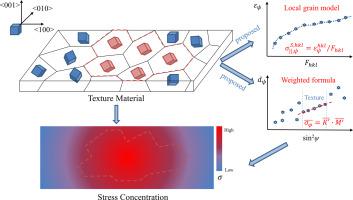当前位置:
X-MOL 学术
›
Mater. Charact.
›
论文详情
Our official English website, www.x-mol.net, welcomes your
feedback! (Note: you will need to create a separate account there.)
Determination of the macroscopic residual stress: Modeling and experimental evaluation of texture and local grain-interaction
Materials Characterization ( IF 4.8 ) Pub Date : 2020-11-01 , DOI: 10.1016/j.matchar.2020.110609 He Wei , Yin-li Chen , Wei Yu , Lan Su , Lili Wang , Di Tang
Materials Characterization ( IF 4.8 ) Pub Date : 2020-11-01 , DOI: 10.1016/j.matchar.2020.110609 He Wei , Yin-li Chen , Wei Yu , Lan Su , Lili Wang , Di Tang

|
Abstract When the texture is present in the sheet, it is extremely difficult to test the residual stress based on the X-ray diffraction method. Based on the two extreme traditional Voigt and Reuss models, this paper proposes two specific corresponding local models (local Voigt and local Reuss) for the measurement of the plane residual stress of cold rolled sheet texture materials. The residual stress test results of CuNiSi specimen using these two local models show that the proposed local models are credible and can accurately characterize the residual stress in the specimen. In addition, based on the X-ray diffraction sin2ψ method of the classic residual stress test, a weighted average residual stress calculation method is proposed for cold-rolled texture materials. The dψ-sin2ψ method was used to analyze the effect of texture on residual stress. The results show that the copper texture C{211}〈111〉 in CuNiSi specimen has the effect of concentrating the residual compressive stress in the region. The stress increased by about 50 MPa. However, the effect of brass texture B{011} 〈211〉 and R texture R{011} 〈211〉 on residual stress was not obvious.
中文翻译:

宏观残余应力的测定:织构和局部晶粒相互作用的建模和实验评估
摘要 当板材存在织构时,基于X射线衍射法测试残余应力是极其困难的。本文在两种极端的传统Voigt和Reuss模型的基础上,提出了两种具体对应的局部模型(局部Voigt和局部Reuss)用于冷轧薄板织构材料平面残余应力的测量。使用这两种局部模型对 CuNiSi 试样的残余应力测试结果表明,所提出的局部模型是可信的,可以准确地表征试样中的残余应力。此外,基于经典残余应力测试的X射线衍射sin2ψ法,提出了冷轧织构材料的加权平均残余应力计算方法。采用dψ-sin2ψ法分析织构对残余应力的影响。结果表明,CuNiSi试样中的铜织构C{211}〈111〉具有使残余压应力集中在该区域的作用。应力增加了约50 MPa。然而,黄铜织构B{011}〈211〉和R织构R{011}〈211〉对残余应力的影响不明显。
更新日期:2020-11-01
中文翻译:

宏观残余应力的测定:织构和局部晶粒相互作用的建模和实验评估
摘要 当板材存在织构时,基于X射线衍射法测试残余应力是极其困难的。本文在两种极端的传统Voigt和Reuss模型的基础上,提出了两种具体对应的局部模型(局部Voigt和局部Reuss)用于冷轧薄板织构材料平面残余应力的测量。使用这两种局部模型对 CuNiSi 试样的残余应力测试结果表明,所提出的局部模型是可信的,可以准确地表征试样中的残余应力。此外,基于经典残余应力测试的X射线衍射sin2ψ法,提出了冷轧织构材料的加权平均残余应力计算方法。采用dψ-sin2ψ法分析织构对残余应力的影响。结果表明,CuNiSi试样中的铜织构C{211}〈111〉具有使残余压应力集中在该区域的作用。应力增加了约50 MPa。然而,黄铜织构B{011}〈211〉和R织构R{011}〈211〉对残余应力的影响不明显。











































 京公网安备 11010802027423号
京公网安备 11010802027423号